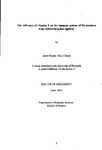The influence of vitamin E on the immune system of the rainbow trout (Oncorhynchus mykiss)
| dc.contributor.author | Roper, Janet | |
| dc.contributor.other | School of Biological and Marine Sciences | en_US |
| dc.date.accessioned | 2013-10-29T11:52:43Z | |
| dc.date.available | 2013-10-29T11:52:43Z | |
| dc.date.issued | 1997 | |
| dc.identifier | NOT AVAILABLE | en_US |
| dc.identifier.uri | http://hdl.handle.net/10026.1/2444 | |
| dc.description.abstract |
This study took the form of three nutritional trials each examining the effects of vitamin E on various physiological, haematological and immunological functions of the rainbow trout. The preliminary study investigated the effect of feeding three experimental diets with different levels of alpha-tocopherol supplementation (0, 100 and 800 mg kgˉ¹ diet), on growth, health and various factors of the non-specific immune response. Liver alpha-tocopherol levels reflected the dietary intake of the vitamin. The fish fed the diet deficient in alpha-tocopherol showed reduced growth and increased mortality They had pale enlarged livers, their hepatosomatic indices and erythrocyte fragility was significantly higher than both the supplemented groups and haematocrit, total serum protein, globulin and complement activity were all significantly lower. No differences were observed between the tissues of the liver, spleen, kidney and heart of the three groups, however the gills structure of the fish fed the diet deficient in alpha-tocopherol showed marked deterioration. The aim of the second trial was to evaluate the effect of feeding different dietary levels of vitamin E (20, 100, 500 mg kgˉ¹ diet) in conjunction with different qualities of oil (fresh or oxidised). In addition to growth and haematological factors, various parameters of the non specific immune response were again evaluated to assess if the feeding of oxidised oil had any effect on these parameters and if the level of vitamin E in the diet had any modulating effect on any differences induced. Fish fed diets containing the lowest level of vitamin E and those fish fed the intermediate level but prepared with oxidised oil, showed classic vitamin E deficiency symptoms, similar to those seen in the preliminary trial and reduced growth and increased mortalities compared to the other groups. Levels of complement activity, were compromised both by low levels of vitamin E and oxidised oil. This suggested that oxidation of the oil content of fish diets increased the requirement for vitamin E and that a high level of vitamin E supplementation was able to compensate to some extent for the deleterious effects induced by the rancid oil. The third trial investigated the effects of different dietary levels of vitamin E (50, 150 and 750 mg kgˉ¹ diet) and immunisation, on antibody responses and mortalities following challenge with Yersinia ruckeri. In addition the effects of diet and immunisation on serum complement activity and levels were measured using three different assay techniques, two based on standard assays and a novel assay, especially developed for this trial, based on an enzyme linked immunosorbent assay (ELISA) technique. This trial, however, did not present any significant results and no correlation between, the level vitamin E supplementation in the diet and antibody response, resistance to Y. ruckeri infection in rainbow trout, could be established. The studies showed that rainbow trout fed diets deficient in vitamin E were immunologically compromised and showed reduced growth and increased mortalities. There appeared to be a definite trend for enhancement of some immunological functions correlated with increased dietary supplementation with vitamin E but this was not always statistically significant and the benefits of dietary supplementation of vitamin E at levels above those currently | en_US |
| dc.language.iso | en | en_US |
| dc.publisher | University of Plymouth | en_US |
| dc.title | The influence of vitamin E on the immune system of the rainbow trout (Oncorhynchus mykiss) | en_US |
| dc.type | Thesis | |
| plymouth.version | Full version | en_US |
| dc.identifier.doi | http://dx.doi.org/10.24382/4126 | |
| dc.identifier.doi | http://dx.doi.org/10.24382/4126 |
Files in this item
This item appears in the following Collection(s)
-
01 Research Theses Main Collection
Research Theses Main


